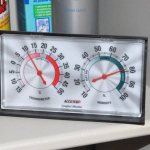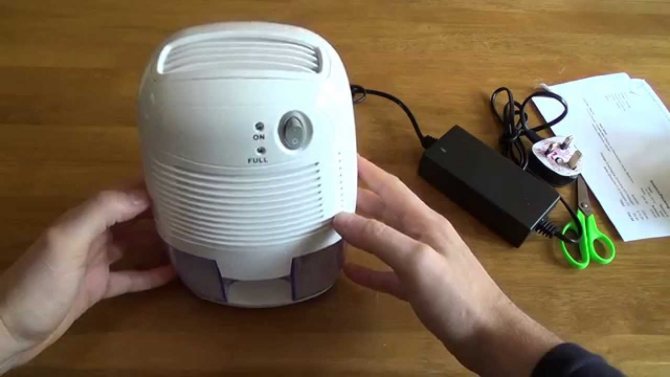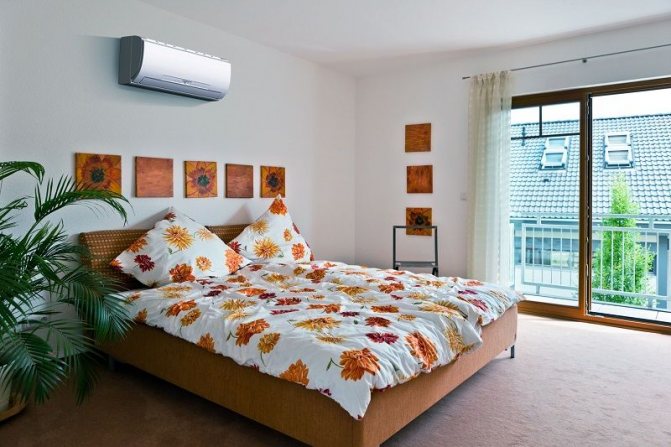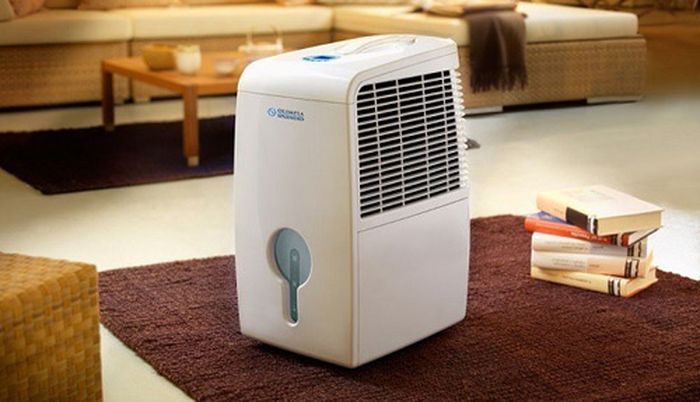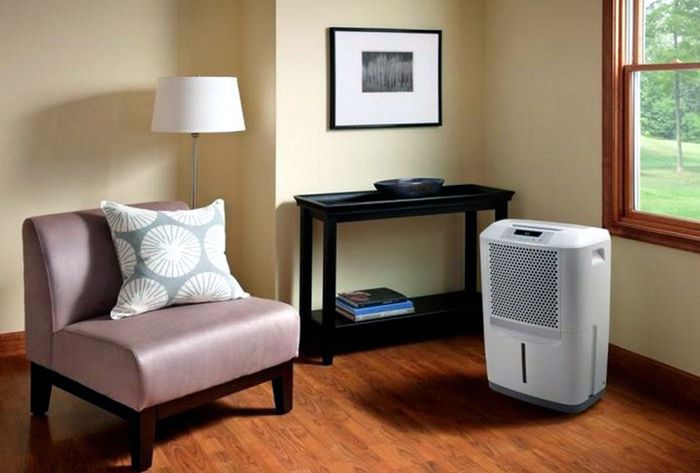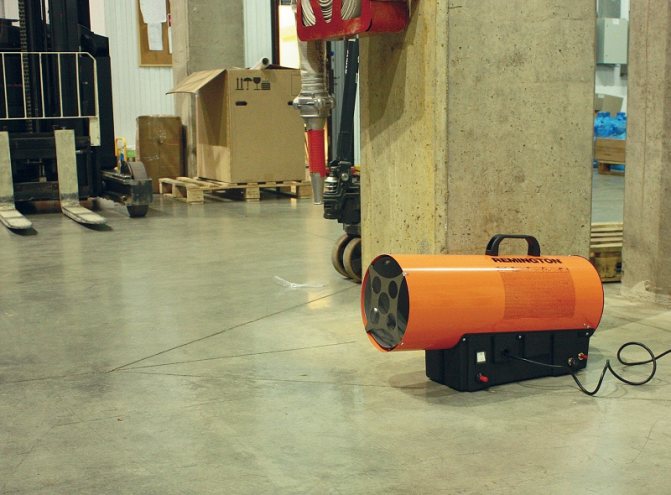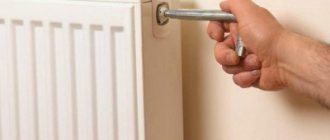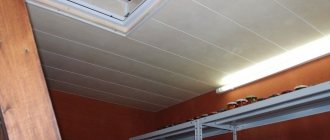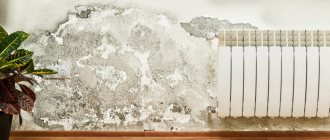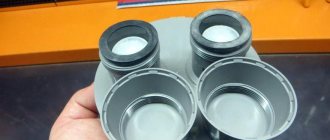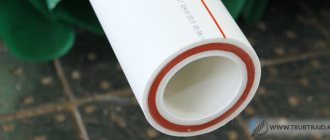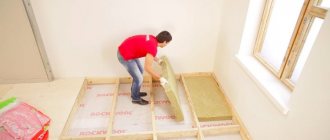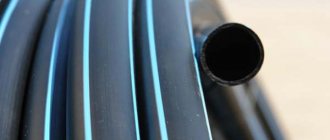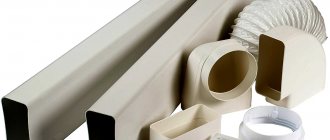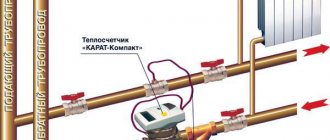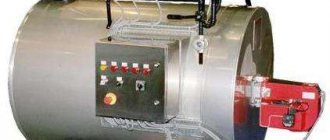Measurement and norms of humidity level
When assessing the state of atmospheric air, it is necessary to be guided by the requirements of GOST and SNiP. The permissible and optimal level of humidity in rooms for various purposes is regulated by GOST 30494-96. To assess the state of the air, the ratio of the amount of water vapor to the volume of the room is used. Thus, they find out the relative humidity of the air, calculated as a percentage. The allowed range is 40-60%.
Optimal values for rooms:
- kitchen - 40-60%
- bedroom - 40-50%
- rooms with computer and electronic equipment - 30-45%;
- children - 45-60%.
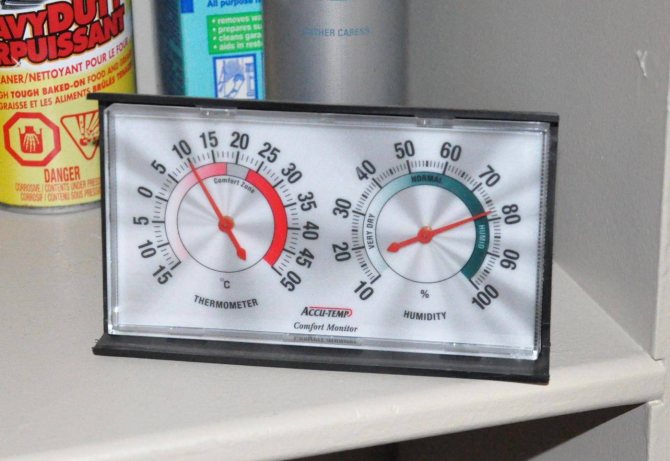
The humidity level directly depends on the air temperature. Therefore, the optimum values vary depending on the season. In the cold season, the permissible indicators are 30-45%, in the warm season - 30-60%.
Household and professional hygrometers are used for measurement. These devices are of several types:
- hairy;
- condensing;
- ceramic;
- weight;
- film.
Household hygrometers are available as desktop or wall-mounted appliances. In addition to their main function, they can be equipped with additional options:
- show time and date;
- Atmosphere pressure;
- air temperature.
Complex devices that combine the functions of a barometer and a thermometer are more advantageous in that they allow full control over the state of the air.
The variety of models is so great that it will not be difficult to choose the one that is most harmoniously combined with the style of a particular room.
Alternative moisture measurement methods
- Pharmacies sell psychrometric hygrometers, the readings of which are calculated using a special Assman table (included in the package).
- You can understand what the level of humidity is with the help of an ordinary glass of water. It is placed in a refrigerator and cooled to -3-5 ° C. They are transferred to the room and after 5 minutes the situation is assessed. If the condensation on the walls of the glass is completely dry, the air is dry, the humidity is below normal. If there are medium-sized drops remaining, compliance with the norm. If streams of water flow down the walls, the humidity is increased.
How to reduce indoor humidity
Identify the source of dampness in your home and take steps to eliminate it. You can dry the air in the apartment with the help of specialists:
- call a plumber;
- call a repairman or install a high-quality heating system;
- order wall insulation from the outside;
- order the repair and installation of window panels;
- hire a craftsman to repair or install a high-quality hood;
- call the master to seal the seams or cracks.
You are able to eliminate other reasons and dry the air in the room yourself:
- make frequent ventilation;
- dry your laundry on the balcony or outside;
- buy an air dryer;
- buy desiccant tablets;
- buy an additional device for heating the room;
- if possible, allow natural sunlight to illuminate the room.
Do you know what the optimal humidity should be in a nursery? If not, here's a helpful article on the topic. And we also have a detailed article on the norms of humidity in the apartment.
Reason number 3. Unheated room
Extreme savings on heating on the principle of "only warm air in the room" is the most common reason for the dampness of the "crying walls" of an apartment or house. The wall should be heated to at least half the thickness.Then the dew point (the place of condensation formation) will come to the side of the street. A frozen wall shifts the dew point closer to the warm area, and sometimes even to the inner plane.
This problem often "works" in conjunction with a lack of ventilation. Abandoned or low-heated premises damp very quickly - finishing materials are destroyed in 2 seasons, the construct loses up to 5-6% of its strength annually (in addition to natural wear and tear). It is highly undesirable to combine heated and unheated (according to the project) premises under one roof.
How to fight
Increase heating.
Try to calculate how much damage your home can get from the merciless dampness and the amount you will save on heating. Then compare these amounts and make a conclusion. Of course, the insulation must be of high quality and timely.
If it is not possible to increase the temperature, install fans on the heating devices and provide short-term ventilation - the humidity will equalize. Do not leave the house unheated, if you are going to return - find a person who will heat it.
How does a dehumidifier work
There are several types of indoor dehumidifiers. They differ in principle of operation and design features:
- evaporative - driving streams of moist air through the evaporator, returns it dehumidified back to the room, and excess moisture flows into the tank;
- adsorptive - the air passes through the adsorbent, which absorbs excess moisture; in parallel, with the help of hot air, the adsorbent dehumidification process takes place. The air comes out back not only dry, but also purified;
- assimilation - takes moist air masses from the room and throws them out into the atmosphere.
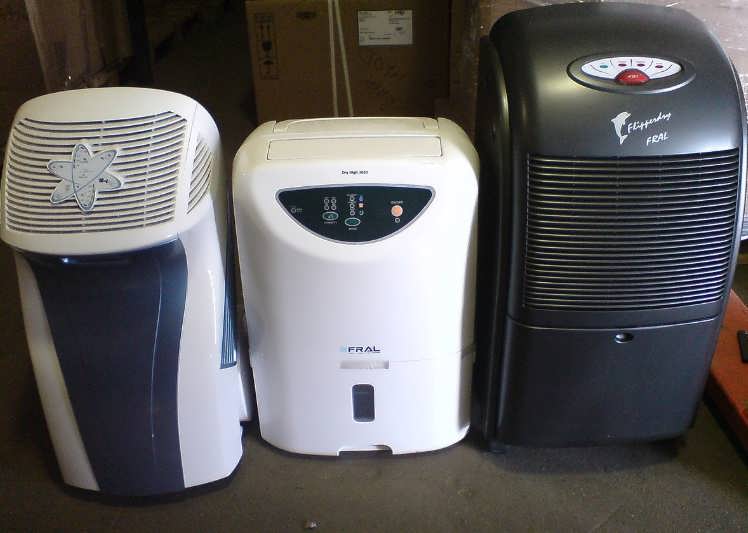

Dehumidifiers
Reason number 4. Incorrect insulation
Thermal insulation of walls with cheap and lightweight foam or expensive modern extruded polystyrene foam has already gained momentum and is becoming a welcome event for residents of apartment buildings. Almost no one ever makes a thermal calculation of the walls of an apartment to determine the thickness of the insulation. Therefore, when choosing a layer of insufficient thickness, the wall continues to freeze and damp.
Life in such a "thermos" can spoil the dampness in the apartment and the inevitable fungus. The reason is the same dew point, which is snugly located between the panel (wall) and the insulation slab. In addition, the vapor permeability of the sonicated materials is close to zero and this is not the only problem with the foam. This cheap, handcrafted material is extremely flammable and toxic when heated. Keep this in mind when preparing to insulate your apartment.
Video: problems with polystyrene foam
How to fight
Explore helpful articles where engineers and builders with extensive experience speak up. Understanding the physics of processes will save you not only from dampness, but also from many other troubles. There are two unmistakable options for insulating an apartment:
- A deliberately excess layer of polystyrene insulation. The thickness of 100-150 mm guarantees that the dew point is outside the wall (in the thickness of the insulation) for any region.
- Breathable insulation. Mineral wool, ecowool, any kind of ventilated facade. This is guaranteed to get rid of moisture in the walls.
Dampness in the apartment can provoke the appearance of mold, which, when it enters the body, becomes the cause of human viral diseases. In addition, humid air by itself is not suitable for everyone. Weakness, soreness, spontaneous loss of performance are what can happen due to excess moisture in the air. Therefore, the elimination of moisture is a concern not only for the native walls, but also for yourself and dear people.
0
The problem of indoor dampness is not as simple as it might seem.Excessive humidity not only creates an unpleasant atmosphere for life, but also has a destructive effect on the building itself, household items and living organisms.
Dealing with dampness is often a time-consuming process that requires serious efforts and material costs.
According to the standards for residential premises, the permissible level of relative humidity is 40-60%. If the moisture content in the air becomes higher, it can negatively affect the quality of life in the home.
First of all, the harm that dampness causes to people living in the room is taken into account. In the humid air, fungi, mold spores and other pathogenic microorganisms spread intensively, which enter the human body through the lungs and skin. Even if they do not cause specific diseases, they worsen overall health:
- Colds become more frequent and more severe.
- Allergic manifestations intensify.
- Painful weakness occurs.
- Working capacity is deteriorating.
An unfavorable atmosphere forms in the room. There is a specific smell of dampness, which eats into clothes and furniture. The shelf life of food products is reduced, especially bread, cereals, flour.
Almost the entire housing environment suffers:
- Door frames and floor coverings are deformed.
- Mold and mildew stains appear on the walls.
- Wallpaper bulges and falls off the walls.
- Clothes and linens in the closet take on a musty smell.
- Products made of leather and wood, books damp and become unusable.
How dehumidifying tablets work
The kit consists of an absorbent tablet that fits into a special holder. A tablet of numerous crystals that absorb excess moisture from the air, they are placed in a plastic case.
By the way, we also recommend to your attention useful material about plants that purify the air in the apartment.
During operation, the tablet works as an adsorbent that absorbs liquid from air masses. Subsequently, the moisture is transformed into a saline solution, which flows into a reservoir to drain the accumulated liquid.
This entire structure must be placed on a flat surface at a distance of at least 10 cm from the nearest wall. Do not install it near a heat source. It is recommended to choose places that are not accessible to children and pets. One device is enough for a room up to 20 m².
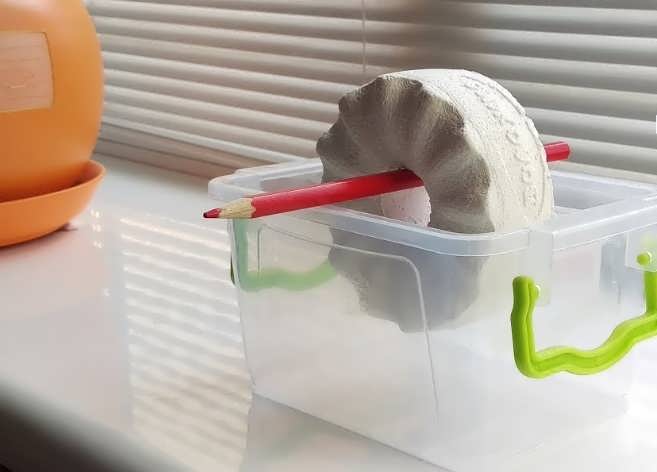

Desiccant tablets
Air-drying tablets also effectively counteract the spread of fungal mold spores, eliminate the effect of condensation on the surfaces of windows, walls, and household items. Eliminate the unpleasant odor of dampness in the house. Change the tablets every 2-3 months, after they are completely dissolved.
Expert opinion
Nikonorov Vladimir Alekseevich
Our expert. Air conditioning and ventilation specialist with 10 years of experience.
Ask a Question
Use absorbent tablets in areas most prone to condensation - bathrooms, kitchens, garage, attic and basement. The use of a drying device in these "hazardous" areas will be most effective.
Mold on the walls
The appearance of mold in the house is possible if high humidity (70% or more) has existed for a long time. Of the huge variety of types of mold in nature, only a few can appear in a human dwelling:
- Black is the most dangerous variety. Refers to the fourth group of pathogenicity. Especially often it affects building structures.
- White - rarely forms on the walls, only if there is condensation for weeks;
- Blue - affects wooden walls, leads to rotting of the material from the inside, its cracking.
In addition to its unaesthetic appearance, mold is also harmful to human health.The reason for this is the saturation with mycotoxins that destroy any kind of living tissue. Ingestion occurs both through direct contact and through the release of spores and their penetration into the respiratory system. If you do not remove the dampness in the house on the walls before mold develops on them, the following diseases are possible:
- Skin lesions - mycoses, dermatoses;
- Respiratory tract damage - asthma, bronchitis, cough;
- Digestive system disorders;
- Exacerbation of chronic diseases - the nervous system, the musculoskeletal system.
The presence of mold is especially difficult for allergy sufferers and people with pulmonary insufficiency.
How professional equipment works to dehumidify indoor air
The surest way to get rid of annoying dampness in your home is to pick up and buy a professional dehumidifier. Especially when the other methods did not have the proper effect.
There are two types of professional dehumidifiers:
- stationary dehumidifier - it is installed on the wall, in the future it will be impossible to move it, so choose the right place for fastening;
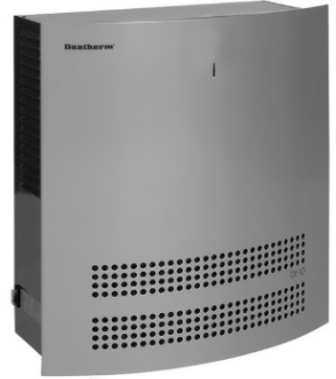

Stationary dryer
- portable - it is not attached to the surface, it is characterized by ease of use and mobility, it has a small size, so it is easy to move it to the required room.
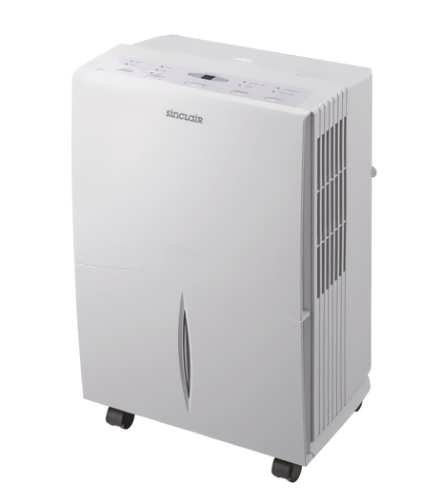

Portable dehumidifier
Remedies
Having found the cause of the formation of high humidity and eliminating it, you can start drying the room. Costly methods such as the use of heat guns are necessary only to eliminate the consequences of flooding or for very large rooms. In an apartment or a private house, the following measures are capable of quickly eliminating dampness on the walls:
- Heater - the device provides air convection; even a small heater will cope with the task in 1-2 days;
- Household dehumidifier - unit capacity is determined by the size of the dwelling; to eliminate dampness on 50 m², a 400 W device is sufficient;
- Silica gel is a substance that absorbs moisture and organic vapors from the air; for use in everyday life, it is admitted in the form of granules, they must be decomposed in a damp room; drying can take up to a week;
Finally, dampness is negatively affected by the rise in temperature in the house. Using a heating system or fireplace at full capacity, walls can be dried relatively quickly. At the same time, the method is poorly suited for houses made of timber - due to the direct effect of high temperature, wooden structures can crack.
Do-it-yourself dehumidifier for an apartment
Why do you need to buy an air dehumidifier if you can independently and quite easily construct it from improvised means and at home.
The first way
- Arm yourself with glass or plastic containers with a volume of 0.5 liters.
- Next, pour ordinary salt into the container, about half.
- To eliminate unpleasant odors in your home, add a few drops of your favorite essential oil to the salt.
- Place these containers in areas most prone to high humidity.
- Change damp salt as needed.
Second way
- Take two 2 liter bottles.
- Cut the first bottle in half; you need both halves.
- Carefully make two holes in the lower half with a red-hot sharp object for future air release.
- Then fill the container with silica gel, a filler used for cat litter.
- Take the top half without the lid and close the throat opening with a bandage folded in several parts.
- With the neck down, place the top on the bottom.
- Cut off the bottom of the second bottle.
- Place a small fan from the computer processor into the opening so that it draws air into the bottle through the neck and passes it through the desiccant.
- Put this bottle with the neck up on the first one, secure the structure with electrical tape.
The dehumidifier is now ready for use. After a couple of days, the filler must be replaced with a new one or dried under the influence of high temperatures.
Remedies
Molds are hard to remove. In all cases, the final coating will have to be completely removed - wallpaper, plaster, and with a large depth of damage, putty to the very base of the wall. The only exception can be a painted surface, since mold hardly penetrates the paint layer, but spreads more over its area.
It is most reliable to remove mold and dampness in the house with the help of chemical compounds, some of which are easy to prepare at home:
- Antiseptic primers - special products with a high content of fungicides; with their help, you can process the wall to a depth of 0.5 cm;
- Household bleach - any type that contains sodium hypochlorite will do;
- Hydrogen peroxide - a 3% composition is used; due to the whitening effect, it is not suitable for treating painted surfaces;
- Potassium permanganate - in everyday life it is found in the form of a solution of potassium permanganate; used as a mixture - 15 g per 1 liter of water;
- Vinegar and citric acid are effective in the early stages of mold development.
Even after elimination of the fungus, a characteristic unpleasant odor remains in the room. A simple method to get rid of it is to treat the overlays with a baking soda solution. For its preparation, 15 g of the substance is dissolved in 100 ml of water.
What are the devices for reducing air humidity and how they work
When a person has already decided to get rid of the problem associated with steam generation in the room, and intends to buy a device, he must decide for himself which device to choose.
Today there are two types of climatic technology, which are similar in efficiency, but fundamentally different in design and principle of operation, which reduce the level of humidity in the room:
- condensation air dryers;
- adsorption devices.
In addition, there are these devices for household and industrial use.
Appliances used for apartments and offices must have an attractive design. Its productivity is 10-100 liters of liquid during the day. Most of them have a practical control panel, a humidity sensor of air masses, a timer. Additionally, it can work as an air purifier, since there is an air filter there.
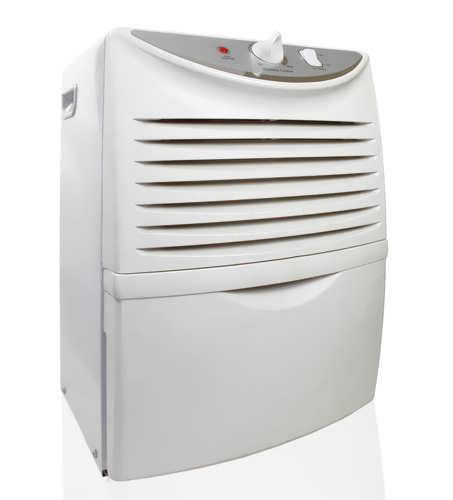

Industrial dehumidifiers are needed for basements, warehouses and industrial premises. The design of the device fades into the background here, because the most important thing is its productivity (from 100 liters per day). This technique is housed in sturdy steel cases, and because it is heavy, there are wheels and handles for easy handling. Often these dehumidifiers are equipped with heating elements, which allows them to be used for space heating.
Since moisture absorbers are not yet widely known devices for our potential buyer, it makes sense to get to know each of them more closely.
Condensing air dryers
Devices that help get rid of excess moisture, for the most part, resemble air conditioners. The advantages of these devices are in a fairly low price, high power, energy efficiency.
Their disadvantage is that they cannot dry the air less than 40% relative humidity. The temperature limits of their effective work are 15-30%.
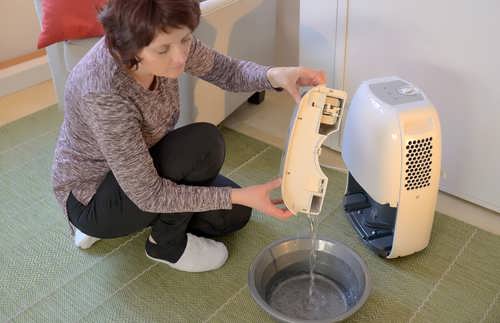

The essence of their work is the passage of moist air and converting it into condensate. Air masses enter the dehumidifier using a fan, where there are 2 shell and tube heat exchangers containing freon. They take heat from the air and heat up themselves. The refrigerant changes its structure from liquid to gaseous. Condensation forms as a result of the passage of humid air.Freon in gaseous form returns to the compressor, again changes its structure and becomes a liquid. When the steam turns into water, dry air is returned back to the room.
Desiccant air dryers
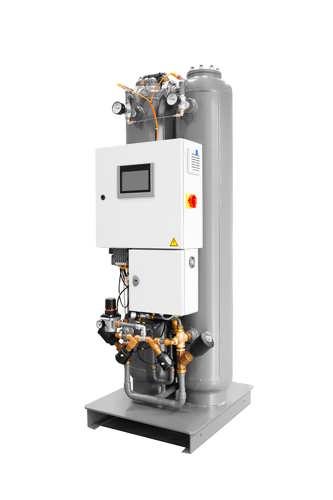

The advantage of this type of dehumidifier is that it can dry air streams up to 30% relative humidity. The desiccant dehumidifier is able to remove water from the air even at subzero temperatures, unlike the first type. These properties are often used for basements and cellars. The disadvantages include frequent replacement of adsorption filters.
The operation of these devices is based on adsorption, that is, the absorption of water from air masses. The element containing a substance that absorbs moisture is called a rotor. There are also 3 fans, and each of them has a specific function. The first one draws in air masses and delivers them to the adsorbent, and it immediately absorbs moisture. Partially compressed air moves forward into the distribution chamber, which divides it, and passes part of it into the space of the room, and partly heats it up in a separate chamber with a heating element. The second fan directs these flows back to the rotor, where it gets rid of the remaining moisture. The next air movement device directs it to the outlet of the dehumidifier. This climatic technique will relieve stale air, misted windows, condensation and the formation of fungus.
Although the demand for dehumidifiers is lower than for humidifiers, they are often indispensable in the event of dampness. These devices bring the parameters of air humidity to normal values, which contributes to the formation of a favorable microclimate for human health and the safety of furniture and premises.
Do it yourself
A homemade dehumidifier is ideal for those looking to save money.
To make an air dehumidifier for your apartment with your own hands, you will need an old freezer. Of course, it must be working. Organic glass, the dimensions of which correspond to the dimensions of the camera. And also self-tapping screws, sealant (can be replaced with silicone glue), several fans, a hollow rubber tube and an electric heater.
All of these items will cost you less than buying a household dehumidifier from a store.
How to make a DIY condensing dehumidifier:
The freezer door must be removed
Unscrew the hinges carefully and set aside. Take organic glass, mount a fan in the lower part. It must be positioned in such a way that the air flow goes into the chamber.
The fan is fastened with self-tapping screws, the joints are well treated with a sealant. The second fan is mounted on the top of the plexiglass. It must be placed in such a way that it blows hot air into the room. Then you need to install the hollow tube. This part of a homemade dehumidifier is needed to remove moisture. A container is placed under it, where water droplets will flow. The pipe itself is mounted in the lower part of the device. It remains to put the structure in the freezer. Such a device does not look very nice, but it is cheap.
As you can see, dehumidifying the air in the apartment is not a problem on your own. You can always get rid of dampness in the room.
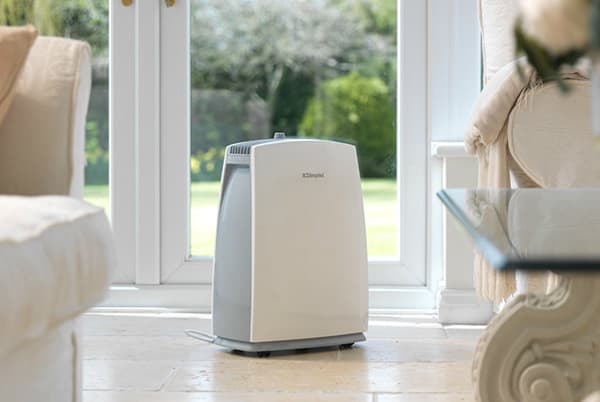

You can make a desiccant that requires a minimum of purchased parts and takes a little time. It is easy to make such a device.
How to dry the air in an apartment:
- Prepare the bottle. Take a plastic container with a volume of 2–5 liters. Choose the volume. depending on the humidity in the apartment. If it reaches 99% in the bathroom, you will need a 5 liter plastic bottle. Also useful are scissors, silica gel, 1 fan, glue gun, awl, bandage (electrical tape, tape, adhesive plaster).
- One bottle is cut in the middle. The awl should be held over the fire and a small hole should be made in the bottom, preferably several.Dried air will come out through these holes.
- The top of the bottle is covered with gauze or bandage. Secure them with tape or tape.
- The cut off part must be turned upside down, and silica gel should be poured into it. For a 2 liter bottle, 200 gr is enough. This part needs to be inserted into the lower half.
- Next, in the bottom of the second bottle with a hot awl, make many small holes or one large one with a clerical knife.
- A fan is attached to this hole. It must be installed in such a way that it works for injection.
- Seal all cracks well with a sealant or glue gun.
- Insert the container with a built-in fan into the first bottle.
- Turn on the fan and dry the air.
From DIY devices. there is not so much benefit as from a purchased household appliance. But these desiccants and desiccants work effectively.
Pay a little attention to making or buying the device. Do not underestimate the harm that high humidity can cause to furniture, books, things and even the health of all the inhabitants of the apartment.
Installation methods
The main type of such climatic equipment is very easy to operate and reliable. To connect the dehumidifier, you just need to plug the wire into the socket, see the amount of liquid in the tank where the condensate is collected, and select the desired level. The dehumidifier will automatically monitor the humidity in the room. The timer can even limit the operating time of the device.
- Floor appliances. For such devices, you just need to choose a suitable place and place it on the floor. You need to pay attention to drainage, with the help of which moisture will be removed. The main thing is the correct cable entry.
- Wall-mounted dehumidifiers. This type of area will not take much, since it should be attached to the wall with the help of special brackets that are included with the purchase. True, it will be difficult to install this dehumidifier on your own, and you cannot do without calling a specialist.
- Universal dehumidifiers. They are wall and floor mounted, depending on the situation and needs.
- Concealed dehumidifiers are most often installed in an adjacent building to get rid of the noise associated with the dehumidifier. Such a system is complex in design and includes the installation of air ducts.
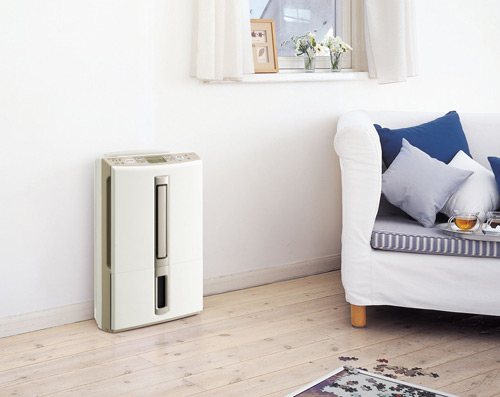

If we differentiate dehumidifiers according to the method of installation, then stationary and mobile types are distinguished. The first ones are mounted in a fixed position and require constant presence in a specific place. It is forbidden to install these devices near heating devices, and for better air circulation, they can be installed in the middle of the room.
Such a device will perfectly cope with high humidity, since it has no equal in power. Mobile dehumidifiers are driven by wheels located on the housing. These devices are used when it is necessary to dry the air in several rooms, and they are irreplaceable in the repair and elimination of leaks.
Air conditioners
Installing a domestic air conditioner will also help get rid of the problem of high humidity in the room. In addition to a comfortable indoor climate, the air conditioner helps to ventilate the room and remove dust and dirt. Cleaning takes place using modern filters. The device controls the level of humidity, so its use is especially important in rooms where there are a lot of people. With the device, you can adjust the room temperature to the nearest degree, which helps to get rid of the sultry heat or extreme cold. Modern air conditioners are equipped with intelligent systems. Therefore, the device works even when the person is absent and does not control it. The air conditioner can be programmed for various kinds of tasks.
Before purchasing various devices for absorbing air humidity, it is necessary to determine in which rooms these devices will be used.In addition, it must be remembered that excessively dry air is also harmful to the human body. In rooms with low humidity, there is a high probability of the spread of various bacteria and viruses.
DIY instructions for creating a condensation dehumidifier
The most popular type of dehumidifier for an apartment is based on condensation - the release of water from the air when the temperature drops. An example of condensation is dew fallout, it is this process that is reproduced in a technological way. The moisture trap cools the air like an air conditioner, but without removing heat outside the room.
Equipment
Components of the device and principle of operation:
- the evaporator is a cold heat exchanger (in it the air is brought to a temperature below the dew point);
- the condenser is a hot heat exchanger (in it the dried air is reheated and released outside);
- storage (condensate flows into it).
A home appliance can be easily constructed from an old refrigerator with a working compressor. For assembly you will need:
- unused refrigerator;
- plexiglass with a thickness of more than 3 mm;
- household fan with power from 100 W;
- plastic grill (pressure head);
- fasteners (screws);
- sealant (electrical tape, silicone);
- tools (screwdrivers, screwdriver, hacksaw for metal).
From these components, the device must be assembled according to the instructions.
Assembly
It is necessary to carry out the work in steps:
Refrigerator desiccant
- First of all, you need to remove the doors from both chambers of the refrigerator.
- Next, you need to measure the dismantled parts and cut out similar sheets of plexiglass.
- From the borders of the sheets, you need to step back 35 cm and cut out the holes for mounting the fan.
- At the next stage, it is necessary to install a grate and a fan in the hole (it should direct the air into the chamber), fix it with self-tapping screws.
- Drill holes at the top of the plexiglass sheet.
- After that, you need to install the sheet in place of the doors of the refrigerator compartment and freezer.
- With the help of a sealant, you need to close the cracks in the area where the door adjoins the body.
- At the finish line, you need to power the camera and fan.
The device connected to the network will direct the air into the chamber with the operating compressor, where the gas will be cooled, becoming drier. The processed air is discharged outside through the holes at the top of the plexiglass sheet. In stationary devices, it is not necessary to provide a container for collecting the dropped out liquid, the device can be connected to the sewer to drain condensate.
Advice! In order not to overcool the air in the room where the home-made dehumidifier-air conditioner works, experts advise placing the heater opposite. It must be positioned so that the outgoing flow enters the additional device.
Experts note the effectiveness of self-made devices, but they also have a number of limitations. If drying is used in a cold room, the unit can run idle: when trying to additionally cool it, the condensate will freeze. You can dry the air in a humid room in various ways. Sometimes ventilation or well-planned ventilation helps; with constant waterlogging, the use of air dryers will be required. These devices migrated to private housing from production facilities, where they have established themselves as effective fighters against air humidity. Experts recommend that people who are faced with the problem of a “wet” atmosphere at home or at work first test homemade desiccant devices, and only then evaluate the need to purchase a device in a home appliance store.
Violation of the microclimate in a residential building is very often associated with an increase in the level of humidity. Dampness becomes the reason for the appearance of pathogenic microflora in the apartment, which leads to a deterioration in the health of residents, as well as damage to their property and interior.How to independently dry the air in the apartment and prevent the threat of waterlogging in the room in the future? You just need to find out the reason for the ingress of moisture into the home, figure out how to deal with dampness and the types of equipment and substances used to get rid of excess moisture, and apply all this in practice.

